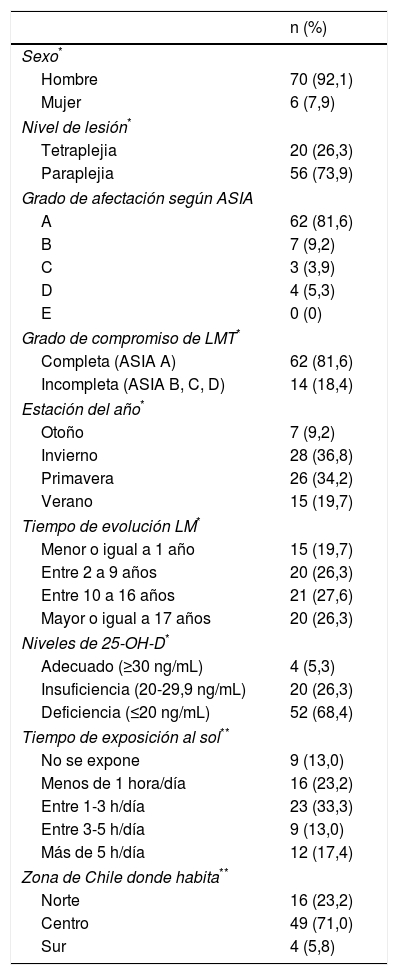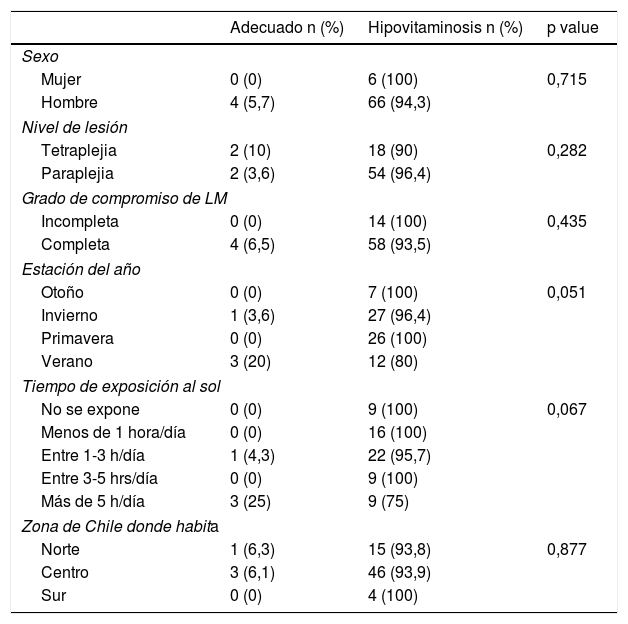La vitamina D cumple un importante rol en el metabolismo óseo y en diversas funciones a nivel extraesquelético. El objetivo de este estudio es determinar la prevalencia de hipovitaminosis D en pacientes con lesión medular traumática (LMT) y describir su asociación con las características de la LMT y demográficas de los pacientes.
Material y métodoEstudio descriptivo prospectivo en 76 pacientes del Departamento de Rehabilitación del Hospital del Trabajador entre el 30 de julio 2015 y el 30 de julio de 2016. Se realizó la medición de 25-hidroxivitamina D (25-OH-D) en sangre mediante el método de radioinmunoanálisis y una encuesta estructurada a los pacientes. Los resultados se analizaron mediante estadística descriptiva, prueba de Kruskall Wallis, rangos signados de Wilcoxon, Chi cuadrado, Fisher y análisis de correlación de Spearman.
ResultadosLa mediana de la edad fue 49,5 años (±DE 15,05), el tiempo de evolución de LMT entre un mes hasta 36 años. El promedio de 25-OH-D fue 16,4ng/mL (4,2 – 45,9ng/mL). El 94,7% de los sujetos presentaban hipovitaminosis D (<30ng/mL) y un 27,6% deficiencia severa (<10 ng/mL). No se encontraron diferencias significativas entre la asociación de hipovitaminosis con sexo, nivel y grado de compromiso de LMT, estación del año, tiempo de exposición al sol y zona donde habitan. Existe una correlación inversa con tendencia a disminuir los niveles de 25-OH-D por cada año de evolución de LMT (Ro=-0,33; p value=0,0040).
ConclusiónLa hipovitaminosis D es altamente prevalente en pacientes con LMT. Es importante diagnosticar oportunamente para su adecuada suplementación y disminuir la prevalencia de complicaciones.
Vitamin D plays an important role in bone metabolism and in various extra-skeletal functions. The aim of this study was to determine the prevalence of vitamin D deficiency in patients with traumatic spinal cord injury (TSCI) and to describe its association with the characteristics of TSCI and patients’ demographic characteristics.
Material and methodA prospective descriptive study was conducted in 76 patients treated at the Rehabilitation Department of Hospital del Trabajador between July 30, 2015 and July 30, 2016. Blood measurement of 25-hydroxyvitamin D (25-OH-D) was performed by the radioimmunoassay method and a structured survey. The results were analysed using descriptive statistics, the Kruskall-Wallis test, Wilcoxon signed-rank test, chi-square test, Fisher test and Spearman rank correlation coefficient.
ResultsThe median age was 49.5 years (SD 15.05) and the time from TSCI was between 1 month and 36 years. The mean 25-OH-D level was 16.4ng/mL (4.2-45.9ng/mL). Vitamin D deficiency (<30 ng/mL) was found in 94.7% of the participants and severe deficiency (<10ng/mL) in 27.6%. No significant differences were found between the association of vitamin deficiency with sex, neurologic level, or severity of TSCI, season, amount of time of sun exposure or geographical area of residence. There was s an inverse correlation with a tendency to decrease 25-OH-D for each year from the onset of TSCI (Ro=-0.33, p value=.0040).
ConclusionVitamin D deficiency is highly prevalent in patients with TSCI. An early diagnosis is important to provide adequate supplementation in order to decrease the prevalence of complications.
Artículo
Comprando el artículo el PDF del mismo podrá ser descargado
Precio 19,34 €
Comprar ahora












